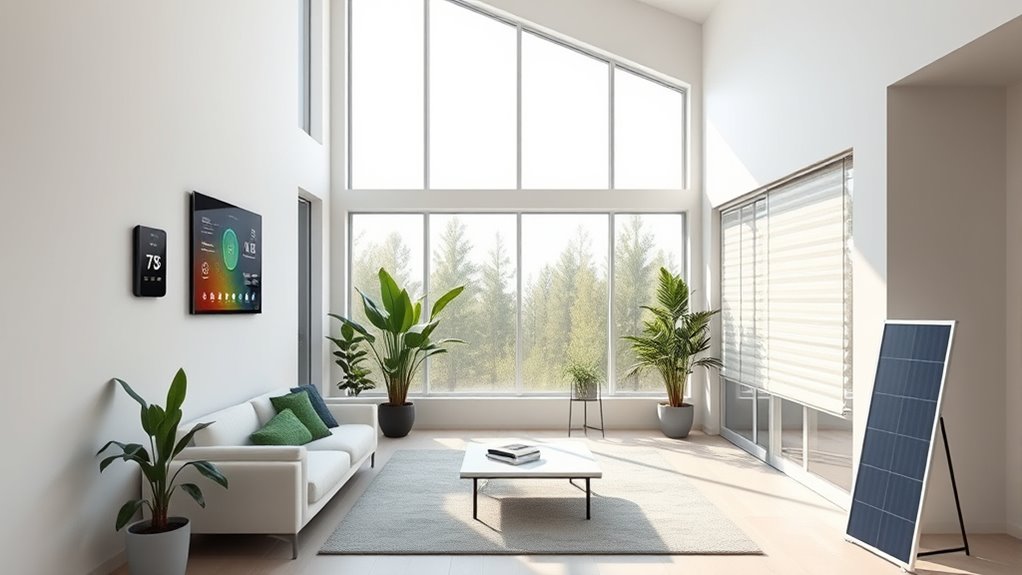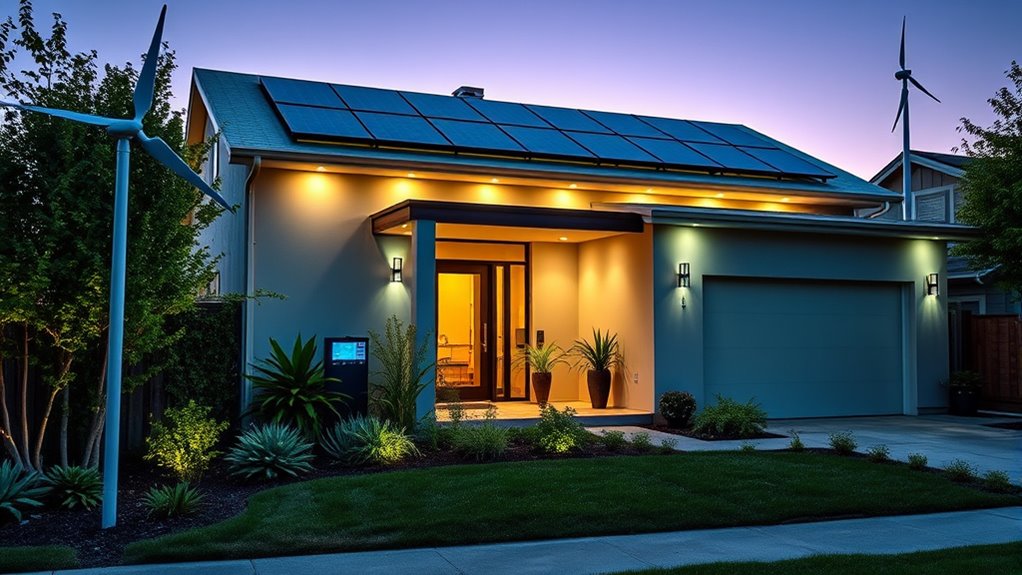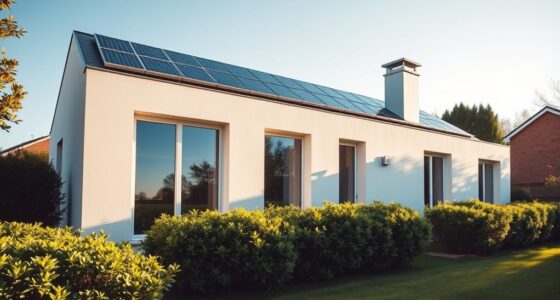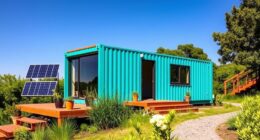Smart homes boost your sustainability by integrating renewable energy sources like solar panels and wind turbines, reducing reliance on fossil fuels. Smart appliances and energy management systems adjust and schedule usage for maximum efficiency, while remote control helps conserve power effortlessly. Smart grid technology ensures your home adapts to fluctuating energy supply, and thoughtful design combines style with eco-friendly features. Keep exploring to uncover how advanced home tech can transform your eco-friendly lifestyle even further.
Key Takeaways
- Integrating renewable energy sources like solar and wind reduces reliance on fossil fuels and enhances home sustainability.
- Smart appliances optimize energy use by adjusting operations based on real-time availability and demand.
- Remote management and scheduling enable efficient control of energy consumption and better utilization of renewable resources.
- Smart grid technology facilitates dynamic energy balancing, demand response, and future-proofing for evolving technologies.
- Aesthetic smart home designs seamlessly combine functionality and style, supporting sustainable living without compromising aesthetics.

Have you ever wondered how smart homes can contribute to a more sustainable future? The answer lies in the way these homes integrate innovative technology to optimize energy use and reduce environmental impact. One key aspect is the use of renewable energy sources, such as solar panels or wind turbines, which can power your entire home or supplement grid electricity. When combined with smart home systems, renewable energy becomes more efficient and manageable. Smart appliances, for example, can automatically adjust their operation based on energy availability, ensuring you use clean energy during peak times and conserve when it’s scarce. This seamless coordination helps you lower your carbon footprint without sacrificing comfort or convenience.
Imagine a home where your smart thermostat communicates with solar panels to determine the best times to heat or cool your space. It can delay running high-energy appliances until renewable energy is abundant, making your household more sustainable. Smart appliances can also monitor their energy consumption, providing you with real-time feedback and suggestions to improve efficiency. For instance, a smart washing machine might delay cycles during the day when solar energy production is highest, or a smart dishwasher could run overnight when grid electricity is less carbon-intensive. These small adjustments add up, reducing overall energy demand and reliance on fossil fuels.
Smart appliances optimize energy use by syncing with renewable sources, reducing demand and environmental impact.
Furthermore, smart home systems enable you to manage your energy use remotely through apps or voice commands. This control means you can turn off unused devices, optimize heating and cooling, and schedule appliance operation to match renewable energy availability. You’re not just passively consuming energy; you’re actively participating in a more sustainable lifestyle. Utilizing energy management systems can further enhance the efficiency of your household by integrating all energy sources and consumption data into a centralized platform. Incorporating renewable energy sources into your home setup can significantly increase your sustainability impact and adapt to future energy trends. Additionally, these systems can help you identify energy-saving opportunities, encouraging smarter energy use habits that benefit both your household and the environment.
A growing trend is the integration of smart grid technology, which allows your home to communicate with the utility provider and optimize energy flow based on demand and supply fluctuations. This integration of renewable energy and smart appliances creates a dynamic, energy-aware environment that benefits both your household and the planet. By choosing smart home technology, you’re also investing in future-proofing your living space. As renewable energy options become more accessible and affordable, your smart home can adapt to incorporate new technologies and sources. This flexibility ensures your home remains energy-efficient and environmentally friendly over the years. Additionally, many smart systems include features that track your energy savings and environmental impact, helping you stay motivated and informed about your sustainability efforts.
In essence, smart homes are not just about convenience—they’re a powerful tool for fostering sustainability. By intelligently harnessing renewable energy and utilizing smart appliances, you can considerably reduce your energy consumption, lower your greenhouse gas emissions, and contribute to a greener, more resilient future. It’s about making smarter choices every day, with technology guiding you toward a more sustainable way of living.
Smart home systems also utilize home decor solutions, such as sleek wall organization systems and aesthetic hooks, to seamlessly blend functionality with style, creating an environment that is both efficient and visually appealing.
Frequently Asked Questions
How Do Smart Home Devices Reduce Overall Energy Consumption?
Smart home devices cut your energy use by enabling energy monitoring, so you can track and optimize consumption. Appliance automation allows you to schedule or remotely control devices, ensuring they run only when needed. This combination reduces waste, saves money, and promotes efficiency. By actively managing your home’s systems, you make smarter choices that lower your overall energy footprint, making your living space more sustainable and cost-effective.
What Are the Initial Costs of Implementing Sustainable Smart Home Technology?
When considering the initial costs of implementing sustainable smart home technology, you should do a thorough cost analysis. The upfront investment varies based on system complexity, device brands, and installation fees. While the initial expenses can be significant, remember that energy savings over time can offset these costs. Planning and comparing options will help you make informed decisions, ensuring your investment contributes to long-term savings and sustainability.
How Can Smart Homes Improve Indoor Air Quality Alongside Energy Efficiency?
You can improve indoor air quality and energy efficiency by integrating air quality sensors and ventilation control systems. These sensors monitor pollutants and humidity levels, automatically adjusting ventilation to keep the air fresh and healthy. This way, you reduce energy waste while maintaining a comfortable environment. Smart ventilation systems respond to real-time data, ensuring ideal air quality without compromising energy savings, making your home healthier and more efficient.
Are There Any Privacy Concerns With Smart Home Energy Systems?
Did you know that 81% of consumers worry about data privacy when using smart technology? With smart home energy systems, you might face privacy concerns related to data privacy and data security. These systems collect usage data, which could be targeted by hackers or misused by companies. To protect yourself, guarantee your devices have strong security measures, like encryption and regular updates, and understand how your data is being used.
How Does Smart Technology Adapt to Seasonal Energy Demands?
You wonder how smart technology adapts to seasonal energy demands. It uses seasonal energy management to adjust heating and cooling based on the time of year, optimizing efficiency. Adaptive climate control systems learn your preferences and automatically modify settings to maintain comfort while conserving energy. This dynamic approach guarantees your home stays comfortable during changing seasons, reducing energy waste and lowering utility bills without you needing to intervene constantly.
Conclusion
By embracing smart home technology, you can turn your living space into a beacon of sustainability, shining brightly in your community. These systems are your secret weapon, helping you cut energy waste and lower bills effortlessly. Think of your smart home as a well-oiled machine, working seamlessly to protect the planet while saving you money. With each smart device you adopt, you’re planting seeds for a greener, more sustainable future—one click at a time.










